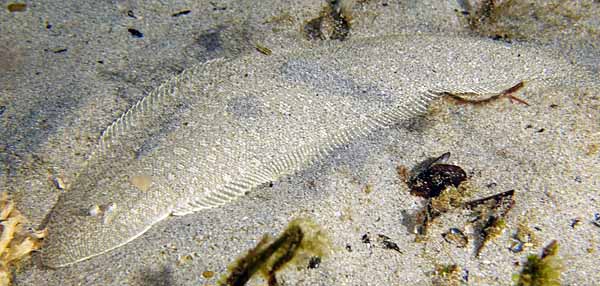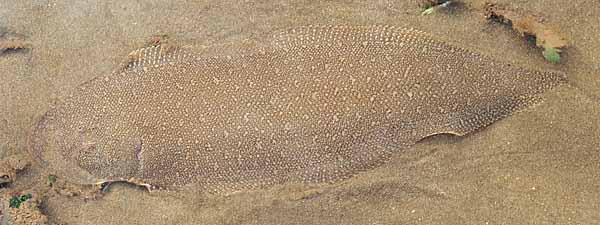Paraplagusia bilineata
(Bloch, 1787)
|
Familie: Cynoglossidae SynonymePleuronectes bilineatus Bloch, 1787
Plagusia dipterigia Rüppell, 1830
Plagusia marmorata Bleeker, 1851
Plagusia unicolor Macleay, 1881 Lokale Bezeichnung |
 Paraplagusia bilineata (Australien, Westaustralien, Cockburn) -- (c) Glen Whisson; iNaturalist; BY-NC 4.0  Paraplagusia bilineata (Australien, Westaustralien, Port Hedland) -- (c) dorisreef; iNaturalist; BY-NC 4.0 |
Typen
Lectotypus: ZMB 2432 .
Siehe: Eschmeyer, W.N., Fricke, R. & Van der Laan, R. (eds.) 2024. Catalog of Fishes electronic version
Typusfundort: China.
Etymologie
Bi- (= zwei); lineatus (= gestreift), bezieht sich auf zwei Seitenlinien auf der Augenseite (damals ein einzigartiges Merkmal im Vergleich zu anderen Plattfischen). (Übersetzt aus: The ETYFish Project)
Verbreitung
Rotes Meer; Indo-Westpazifik: Südafrika, Ostafrika, Persischer Golf, Seychellen, Madagaskar und Maskarenen (Mauritius, Rodrigues) östlich bis Vietnam, Philippinen und Neuirland (Papua-Neuguinea), nördlich bis Südjapan, südlich bis Geographe Bay (Westaustralien), Bateman's Bay (New South Wales, Australien) und Lord Howe Island.
IUCN Status

EX Extinct (ausgestorben)
EW Extinct in the Wild (in der Natur ausgestorben)
CR Critically Endangered (vom Aussterben bedroht)EN Endangered (stark gefährdet)
VU Vulnerable (gefährdet)
NT Near Threatened (potenziell gefährdet)
LC Least Concern (nicht gefährdet)
RE Regionally Extinct (regional oder national ausgestorben)DD Data Deficient (ungenügende Datengrundlage)
NE Not Evaluated (nicht beurteilt)
LC Least Concern (nicht gefährdet)
Gefahren für diese Art: Das Ausmaß ihrer Entnahme in der kommerziellen und handwerklichen Fischerei ist ungewiss. Lokal kann sich die Überfischung negativ auf diese Art auswirken; global gesehen wird die Ausbeutung jedoch derzeit nicht als große Bedrohung angesehen. Da diese Art in flachen, küstennahen Gebieten, einschließlich Ästuaren, vorkommt, kann sie durch anthropogene Aktivitäten in diesen empfindlichen Lebensräumen beeinträchtigt werden.
Literatur
- Bloch, M.E. 1787. Naturgeschichte der ausländischen Fische. Berlin. 3: i-xii + 1-146, Pls. 181-216. Zitatseite [:29, Pl. 188, !!, als Pleuronectes bilineatus]
- Rüppell, W.P.E.S. 1828-30. Atlas zu der Reise im nördlichen Afrika. Fische des Rothen Meers. Frankfurt am Main (Heinrich Ludwig Brönner). 1-141 + 3 pp., Pls. 1-35. [1. Teil (1828): 1-26, Pls. 1-6; 2. Teil (1829): 27-94, Pls. 7-24; 3. Teil (1830):95-141, Pls. 25-35.](BHL) Zitatseite [:123, pl. 31, fig. 3, !!, als Plagusia dipterigia]
- Bleeker, P. 1851. Bijdrage tot de kennis der ichthyologische fauna van de Banda-eilanden. Natuurkundig Tijdschrift voor Nederlandsch Indië, 2: 225-261.(BHL) Zitatseite [:411, !!, als Plagusia marmorata]
- Bleeker, P. 1865-69. Atlas ichthyologique des Indes Orientales Néêrlandaises, publié sous les auspices du Gouvernement colonial néêrlandais. Tome V. Baudroies, Ostracions, Gymnodontes, Balistes. 1-152, Pls. 194-231. Zitatseite [:28, pl. 246, fig. 3, als Paraplagusia macrocephalus]
- Castelnau, F.L. 1875. Researches on the fishes of Australia. 1-52. (PDF) Zitatseite [:44, !!, als Plagusia acuminata]
- Macleay, W. 1881. Descriptive catalogue of the fishes of Australia. Part III. Proceedings of the Linnean Society of New South Wales, 6 (1): 1–138. (PDF) Zitatseite [:138, !!, als Plagusia unicolor]
- De Vis, C.W. 1883. Description of new genera and species of Australian fishes. Proceedings of the Linnean Society of New South Wales, 8 (2): 283-289. BHL Zitatseite [:288, !!, als Plagusia notata]
- Regan, C.T. 1919. Fishes from Durban, Natal, collected by Messrs. H. W. Bell Marley and Romer Robinson. Annals of the Durban Museum, 2 (4) (art. 18): 197-204. (BHL) Zitatseite [:203, fig. 6, !!, als Plagusia robinsoni]
- Rendahl, H. 1922. Meddelelser fra det Zoologiske Museum, Kristiania. Nr. 5. A contribution to the ichthyology of north-west Australia. Nyt Magazin for Naturvidenskaberne, 60: 163-197. (BHL) Zitatseite [:190, !!, als Rhinoplagusia australis]
- Oshima, M. 1927. List of flounders and soles found in the waters of Formosa, with descriptions of hitherto unrecorded species. Japanese Journal of Zoology, 1 (5): 177–204. Zitatseite [:200, !!, als Paraplagusia formosana]
- Ramanathan, N. & Natarajan, R. 1980. The flat fishes of Porto Novo (India) (Pisces, Pleuronectiformes). Bulletin Zoologisch Museum, 7 (10): 89-104. (PDF) Zitatseite [:101f, Beschreibung, Zeichnung, Synonyme]
- Dor, M. 1984. Checklist of the fishes of the Red Sea. CLOFRES. Israel Academy of Sciences and Humanities, Jerusalem. Checklist of the fishes of the Red Sea. CLOFRES.: i-xxii, map + 1-437. Zitatseite [:272f, (in der Fußnote wird dieser Name fälschlicherweise als von Achirus bilineatus Lacepède 1802 vorbesetzt angegeben; trotzdem gültig als Paraplagusia bilineata; Synonyme]
- Daget, J., Gosse, J.-P. & Thys van den Audenaerde, D.F.E. 1986. Checklist of the freshwater fishes of Africa (CLOFFA). ISNB Bruxelles, MRAC Tervuren, ORSTOM Paris. 2: i-xiv + 1-520. Zitatseite [:433, Vorkommen, Synonyme]
- Paepke, H.-J. 1999. Bloch's fish collection in the Museum für Naturkunde der Humboldt Universität zu Berlin: an illustrated catalog and historical account. Ruggell (Liechtenstein). Theses Zoologicae, 32: 1-216, Pls. 1-32. Zitatseite [:68, Lectotypus festgelegt]
- Hutchins, J.B. 2001. Checklist of the fishes of Western Australia. Records of the Western Australian Museum, Supplement No. 63: 9-50. Zitatseite [:47, als Paraplagusia acumineata]
- Hoese, D.F. & Bray, D.J. 2006. Various families and subfamilies: p. 88, 113-115, 116-117, 188-189, 675-685, 1000-1001, 1029-1030, 1031-1033, 1047, 1073-1077, 1176-1182, 1212-1217, 1264-1274, 1280, 1317-1327, 1350-1352, 1363-1365, 1476-1478, 1495-1496, 1497-1499, 1500-1504, 1505-1506, 1507-1508, 1540-1566, 1568-1576, 1578-1592, 1711-1712, 1729, 1787-1792, 1793-1797, 1800-1801, 1804-1805, 1807-1809, 1810-1823, 1824-1825, 1826-1830, 1831-1837, 1838-1840, 1841-1852, 1853-1858. In: Zoological Catalogue of Australia. Volume 35. Fishes. Pt. 1, 2, 3. Zitatseite [:1856, als Paraplagusia acumineata]
- Kottelat, M. 2013. Nomenclature and identity of the tongue soles Paraplagusia bilineata, "Cynoglossus bilineatus" and Paraplagusia blochii (Teleostei: Pleuronectiformes). Raffles Bulletin of Zoology, 61 (2), 763-766. (PDF) Zitatseite [:763, (stellte fest, dass sich bilineata Bloch, "Cynoglossus bilineatus" und Paraplagusia blochii (der Ersatzname) auf denselben Organismus beziehen; und um Tautonymie zu vermeiden, benannte er Paraplagusia bilineata um in Paraplagusia bleekeri. Er betrachtete das Exemplar ZMB 2432 nicht als Lectotypus und synonymisierte die Art fälschlicherweise mit Cynoglossus quadrilineatus (Bleeker 1851)]
- Fricke, R., Golani, D., Appelbaum-Golani, B. 2023. Review of the tonguesoles of the Red Sea, with description of a new species (Teleostei: Cynoglossidae). Taxa, 3: ad24301, [36pp]. (doi) Zitatseite [:22, Fig 19, 20, Farbfoto, Beschreibung, Verbreitung, Synonyme]
Links
- FishBase]]